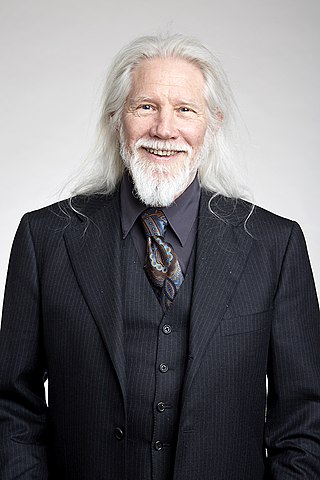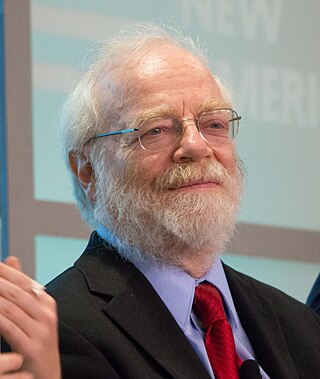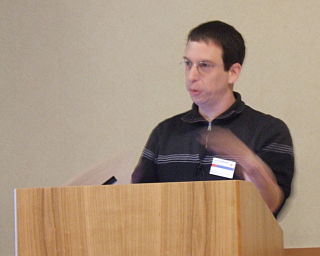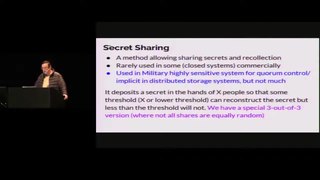
In cryptography, encryption is the process of encoding information. This process converts the original representation of the information, known as plaintext, into an alternative form known as ciphertext. Ideally, only authorized parties can decipher a ciphertext back to plaintext and access the original information. Encryption does not itself prevent interference but denies the intelligible content to a would-be interceptor.
Key escrow is an arrangement in which the keys needed to decrypt encrypted data are held in escrow so that, under certain circumstances, an authorized third party may gain access to those keys. These third parties may include businesses, who may want access to employees' secure business-related communications, or governments, who may wish to be able to view the contents of encrypted communications.
A cypherpunk is any individual advocating widespread use of strong cryptography and privacy-enhancing technologies as a route to social and political change. Originally communicating through the Cypherpunks electronic mailing list, informal groups aimed to achieve privacy and security through proactive use of cryptography. Cypherpunks have been engaged in an active movement since at least the late 1980s.
Articles related to cryptography include:

Crypto: How the Code Rebels Beat the Government Saving Privacy in the Digital Age is a book about cryptography written by Steven Levy, published in 2001. Levy details the emergence of public key cryptography, digital signatures and the struggle between the National Security Agency (NSA) and the "cypherpunks". The book details the creation of Data Encryption Standard (DES), RSA and the Clipper chip.

The Clipper chip was a chipset that was developed and promoted by the United States National Security Agency (NSA) as an encryption device that secured "voice and data messages" with a built-in backdoor that was intended to "allow Federal, State, and local law enforcement officials the ability to decode intercepted voice and data transmissions." It was intended to be adopted by telecommunications companies for voice transmission. Introduced in 1993, it was entirely defunct by 1996.

Bailey Whitfield 'Whit' Diffie, ForMemRS, is an American cryptographer and mathematician and one of the pioneers of public-key cryptography along with Martin Hellman and Ralph Merkle. Diffie and Hellman's 1976 paper New Directions in Cryptography introduced a radically new method of distributing cryptographic keys, that helped solve key distribution—a fundamental problem in cryptography. Their technique became known as Diffie–Hellman key exchange. The article stimulated the almost immediate public development of a new class of encryption algorithms, the asymmetric key algorithms.
In cryptography, Skipjack is a block cipher—an algorithm for encryption—developed by the U.S. National Security Agency (NSA). Initially classified, it was originally intended for use in the controversial Clipper chip. Subsequently, the algorithm was declassified.

Ian Avrum Goldberg is a cryptographer and cypherpunk. He is best known for breaking Netscape's implementation of SSL, and for his role as chief scientist of Radialpoint, a Canadian software company. Goldberg is currently a professor at the Faculty of Mathematics of the David R. Cheriton School of Computer Science within the University of Waterloo, and the Canada Research Chair in Privacy Enhancing Technologies. He was formerly Tor Project board of directors chairman, and is one of the designers of off the record messaging.

Dorothy Elizabeth Denning is a US-American information security researcher known for lattice-based access control (LBAC), intrusion detection systems (IDS), and other cyber security innovations. She published four books and over 200 articles. Inducted into the National Cyber Security Hall of Fame in 2012, she is now Emeritus Distinguished Professor of Defense Analysis, Naval Postgraduate School.
In cryptography, the interlock protocol, as described by Ron Rivest and Adi Shamir, is a protocol designed to frustrate eavesdropper attack against two parties that use an anonymous key exchange protocol to secure their conversation. A further paper proposed using it as an authentication protocol, which was subsequently broken.

Steven M. Bellovin is a researcher on computer networking and security. He has been a professor in the Computer Science department at Columbia University since 2005. Previously, Bellovin was a Fellow at AT&T Labs Research in Florham Park, New Jersey.
Cryptography is the practice and study of encrypting information, or in other words, securing information from unauthorized access. There are many different cryptography laws in different nations. Some countries prohibit export of cryptography software and/or encryption algorithms or cryptoanalysis methods. Some countries require decryption keys to be recoverable in case of a police investigation.

Dan Boneh is an Israeli-American professor in applied cryptography and computer security at Stanford University.

Adam Back is a British cryptographer and cypherpunk. He is the CEO of Blockstream, which he co-founded in 2014. He invented Hashcash, which is used in the Bitcoin mining process.

Cryptography, or cryptology, is the practice and study of techniques for secure communication in the presence of adversarial behavior. More generally, cryptography is about constructing and analyzing protocols that prevent third parties or the public from reading private messages. Modern cryptography exists at the intersection of the disciplines of mathematics, computer science, information security, electrical engineering, digital signal processing, physics, and others. Core concepts related to information security are also central to cryptography. Practical applications of cryptography include electronic commerce, chip-based payment cards, digital currencies, computer passwords, and military communications.

Mordechai M. "Moti" Yung is a cryptographer and computer scientist known for his work on cryptovirology and kleptography.

Vincent (Vinnie) Moscaritolo is a retired American computer security expert known for his work in encryption applications for mobile devices. After decades in the computer industry, he now volunteers as a search and rescue professional. He holds NREMT, WFR, and Amateur Radio Extra Class and a General Radiotelephone Operator with Ships Radar License.

Bullrun is a clandestine, highly classified program to crack encryption of online communications and data, which is run by the United States National Security Agency (NSA). The British Government Communications Headquarters (GCHQ) has a similar program codenamed Edgehill. According to the Bullrun classification guide published by The Guardian, the program uses multiple methods including computer network exploitation, interdiction, industry relationships, collaboration with other intelligence community entities, and advanced mathematical techniques.

Nadia Heninger is an American cryptographer, computer security expert, and computational number theorist at the University of California, San Diego.














